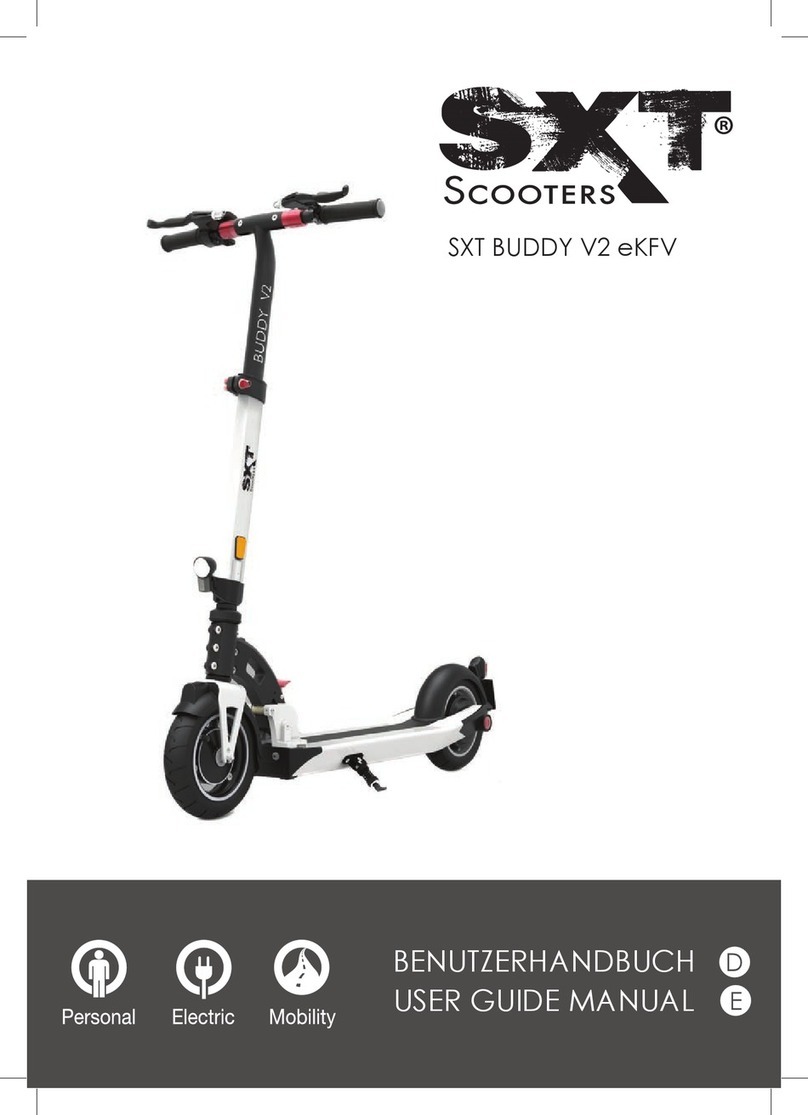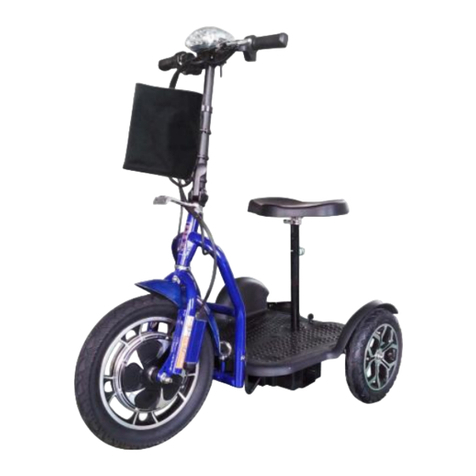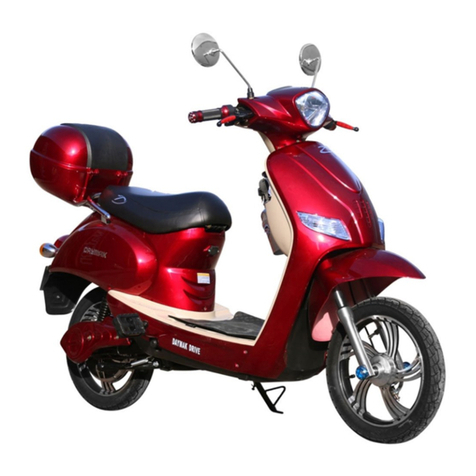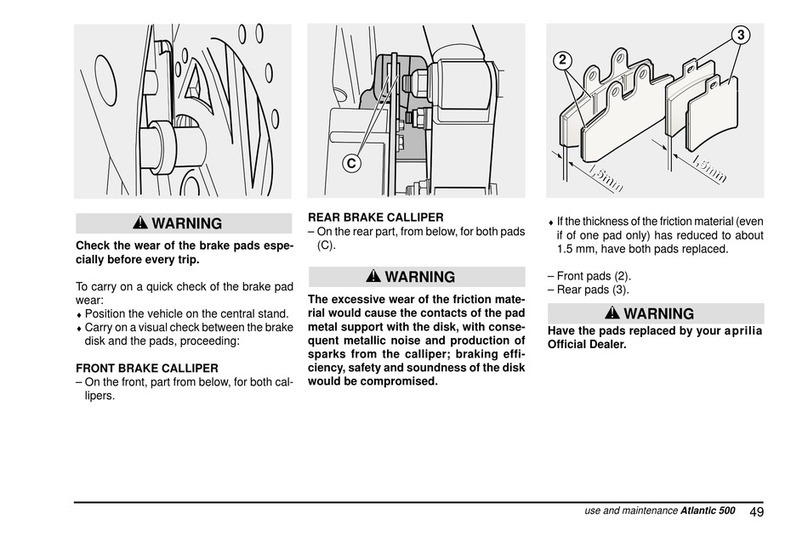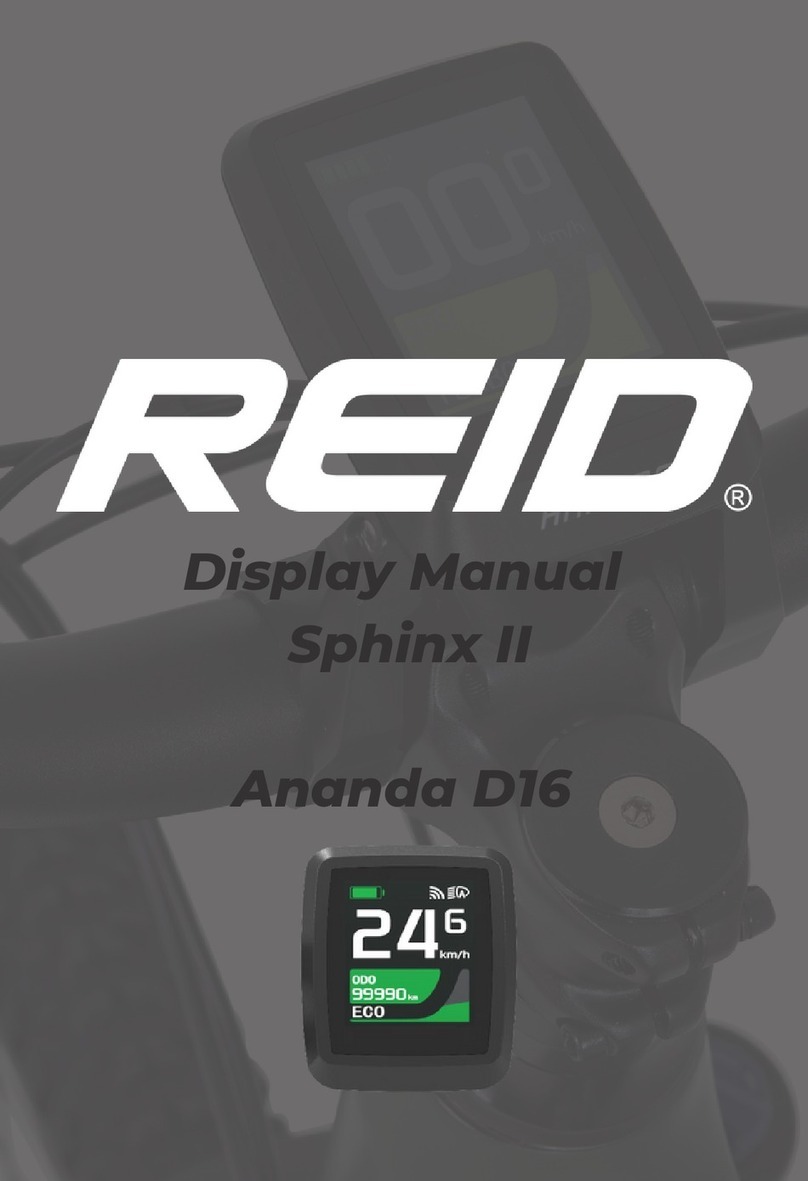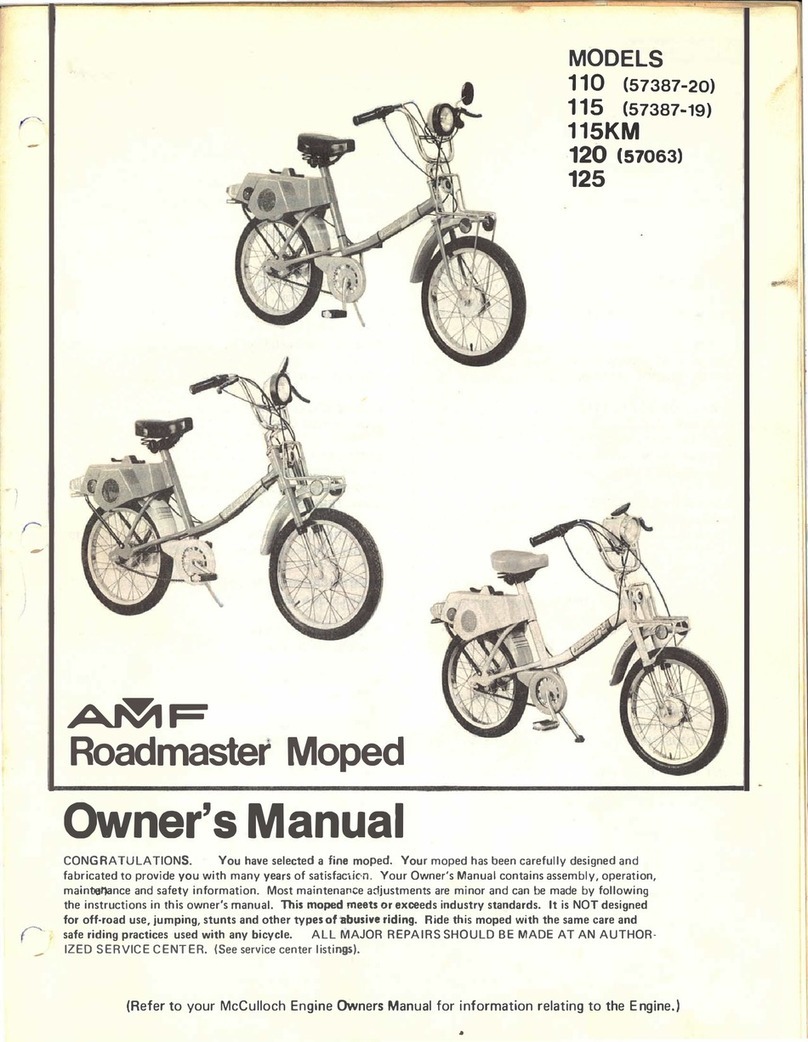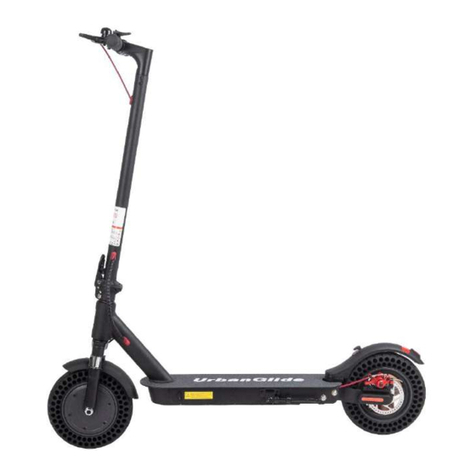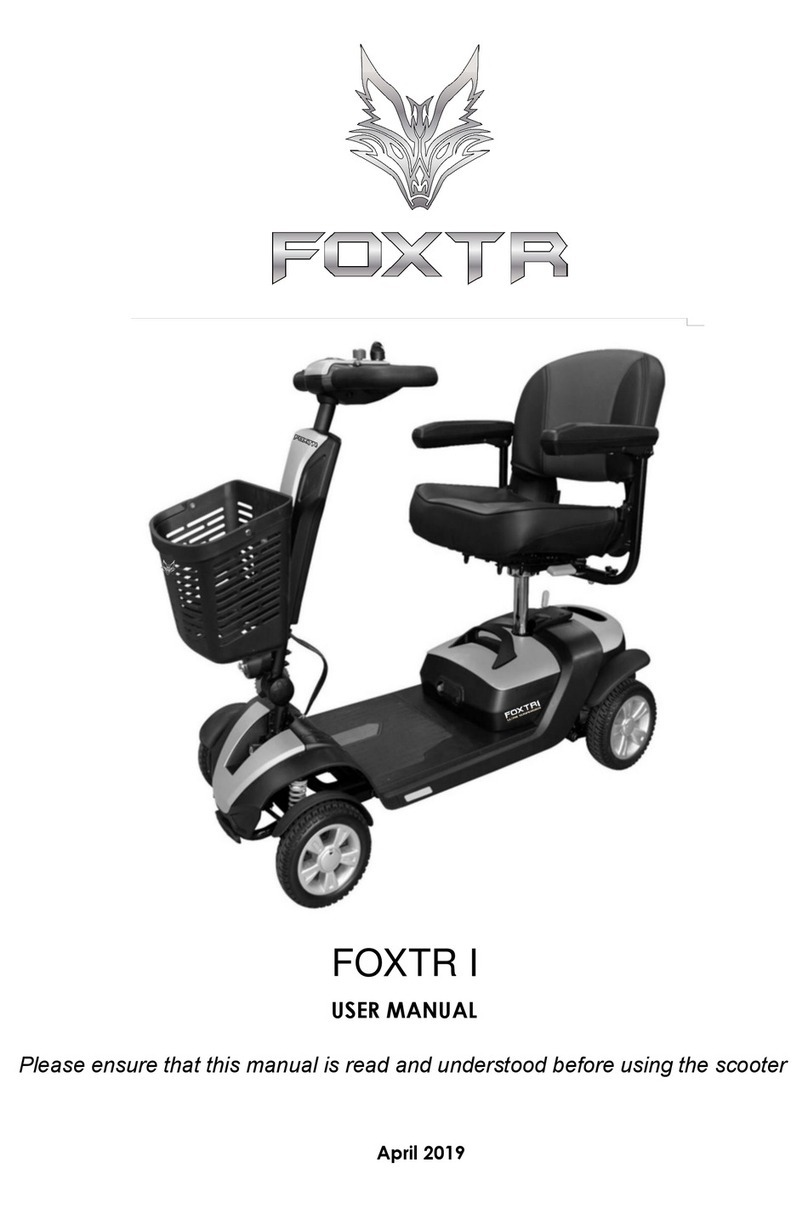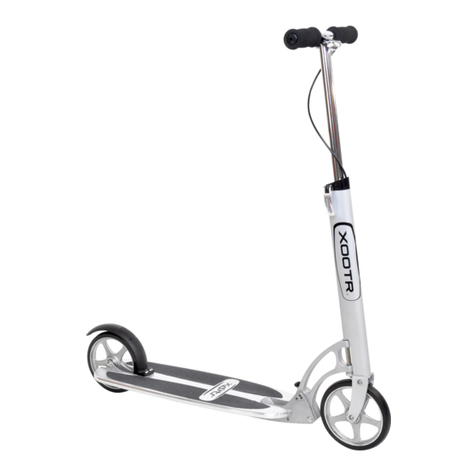Roscoe Medical Knee Scooter User manual

Knee Scooter
Warranty
21973 Commerce Parkway
Strongsville, Ohio 44149 USA Made in China
Warnings
• As with any new physical activity, instruction, practice and
common sense are necessary for successful use of the knee
scooter. Your health professional or knee scooter distributor
can provide instruction and a demonstration. Practice operating
the knee scooter to increase your skill and condence,.
Gradually increase the time you spend using the knee scooter
to allow your muscles to adjust to this new activity.
• Failure to properly engage the quick-release clamp may cause
the steering column to move while the knee scooter is in use
and may cause you to loose control. With the quick release
clamp properly adjusted, the handle bars will be locked in place.
• Be sure to check that the quick-release clamp is secure and
tight before each use or injury may result.
• Injury may result if knee platform setup instructions are not
followed.
• Do not adjust the screw next to the parking brake button.
• Because the knee scooter is lightweight, use of the hand brake
while in motion may cause an abrupt stop.
• Do not use the knee scooter on or near stairs or while
using mind-altering drugs or alcohol or while suffering from
dizziness.
• Do not use the knee scooter to pull yourself up from a seated
position. The knee scooter is intended for use with a person
in place on the scooter.
• Use caution when moving from carpeted to hard surface
oors and on any rough surfaces or when changing levels (for
example, moving from a curb to the street and back onto the
sidewalk).
• Check the knee scooter frequently for any loose cotter pins,
clevis pins or loose nuts or bolts and the quick-release clamp
on the T-tube. Do not use the knee scooter if any pins are
missing.
DO NOT ATTEMPT TO ADJUST OR OPERATE
KNEE SCOOTER WITHOUT READING ALL
INSTRUCTIONS CAREFULLY.
www.roscoemedical.com
This warranty is solely for the benet of the original consumer
purchaser.
This device was built to exacting standards and carefully inspected
prior to shipment. Your Roscoe brand product carries a limited
lifetime warranty on the frame and 90 days on all other non-durable
components including but not limited to rubber accessories, wheels,
grips, brake cable and knee pads, which are subject to normal wear
and need periodic replacement. If within such warranty period, the
product proves defective, the product will be repaired or replaced,
at the option of Roscoe Medical. This warranty does not cover
device failure due to owner misuse or negligence, or normal wear
and tear.
This warranty shall not apply to serial numbered products if the
serial number has been removed or defaced, or to defects or
damages caused by unauthorized parts, attachments or repairs,
negligence, accident, or any circumstance beyond Roscoe Medical’s
control, such as improper operation, maintenance or storage.
If you have a question about your Roscoe product or this warranty,
please contact an authorized Roscoe Dealer.

Brake
Mechanism
Hand Brake
Lever
Quick
Release
Clamp
Knee Platform
Platform
Pin
Congratulations on the purchase of a knee scooter. This medical
device is designed to maximize mobility during your recovery from
foot or ankle surgery or injury.
If you do not understand the manual, contact your dealer for a
complete explanation of the instructions, cautions and warnings.
Otherwise, injury or damage may result.
STEERING COLUMN SETUP - The steering column will be in
a folded position when unpacking it from the shipping carton.
This feature also makes transporting the knee scooter quick and
convenient during everyday use.
TO RAISE THE STEERING COLUMN -
The locking mechanism at
the base of the steering column has an added security pin to prevent
it from collapsing during use. Push the lever to the left and downward
at the same time to disengage the pin and push the steering column
upward until it is in the full upright position. Now, release the handle
to engage the safety pin (the steering column will stand in the upright
position if the safety pin is engaged). Pull the lever down so the
end of the lever is pointing towards the ground to lock the steering
column in the upright position (rotate the lever counter clockwise to
loosen and clockwise to tighten the pressure on the lever).
TO LOWER THE STEERING COLUMN - Pull the lever up to
release the clamp from the steering column and push the lever
forward to disengage. Push the lever to the left and downward at
the same time to disengage the pin and gently guide the steering
column downward.
HANDLE BAR HEIGHT ADJUSTMENT - Handle bars are raised
or lowered by pushing in the button on the steering column and
resetting to correct height. Handle bars should be set at waist level
to keep your back straight. Stand on the side of the knee scooter
where your pushing foot will be. Lock the parking brake. Release
the quick-release clamp on the T-tube and adjust the height of the
Operating Instructions
hand grips to a comfortable upright r. Relock the quick-release
clamp.
KNEE PLATFORM SET-UP - The knee platform can be used for
right or left leg injuries. The offset position of the seat provides
better stability and increased foot clearance for pushing forward.
When standing behind the scooter, the knee platform should be
offset to the left for right leg injuries or offset to the right for left
leg injuries.
Wearing non-slip shoes on your non-injured foot, check the position
of the knee scooter. To adjust the platform for a right or left foot,
remove the platform pin, lift the platform from its frame, turn it
around to the correct side, replace the platform in the frame and
reinsert pin. The edge of the platform should be aligned with the
edge of the frame on the non-injured side. When standing behind
the knee scooter, the platform should be off-center to the left for a
right foot injury and off-center to right for a left foot injury. If you
have a previously unused model, both pads should align themselves
to the end of the platform (see instructions below).
KNEE PLATFORM ADJUSTMENT
1. Adjust the knee platform from the right to the left side (or
vice versa) by unscrewing the large round knob under the
platform and pulling the knob out toward you as far as it will
go. This will allow you to pull out the entire platform and turn
it 180 degrees.
2. Reinsert the platform post and set it for the desired height.
The correct side choice should align the edge of the platform
directly above the frame line on the side of the uninjured leg.
Once in place, either insert the pin and lock the clamp on the
opposite side; or screw the large knob to secure the platform
at the desired height.
3. Center both pads so that the beveled edges t into the
reverse bevel of the knee platform. The vacant area between
the pads is designed for the lip of the cast or boot. Only the
knee without the boot or cast edge should be placed on
the front pad. The lower leg then will rest on the rear pad.
This conguration is especially designed for maximum user
comfort. The knee pads are reversible front to back if you
need to reverse the direction of the platform for a new client.
BRAKE ADJUSTMENT - For parking, the hand lever for the brake
will be in the upright position. Use a 3/16 Allen wrench to loosen
the hand lever and reposition it to a comfortable use position,
re-tightening with the Allen wrench. The pressure of the brake
mechanism on the brake wheel should be enough so that, when the
hand lever is in the fully squeezed position, the brake wheel does
not turn but it is not overly tight. The tightness can be adjusted
with the nuts at either end of the brake cable. Turning the screw
clockwise will loosen the brake and turning the screw counter
clockwise will tighten it.
OPERATION/MOVEMENT
• Place your hands on the handlebars
• Place the knee of your injured foot on the front pad so that
the top of your boot or cast is directly over the space between
the pads. Your lower leg is then resting on the rear pad.
• Release the parking brake and propel yourself forward or
backward with your pushing foot, keeping the knee of your
injured foot centered on the front pad.
• Move slowly so that you can stop safely using your pushing
foot.
• The hand brake may be used if needed but is primarily
designed to maintain a stopped stance.
BRAKING - The brake is engaged by depressing the brake lever on
the handle bar. The braking wheel must be in contact with the oor,
and the brake works best with weight on the knee scooter.
• To use the brake, simply squeeze the lever with your nger
tips toward the handle bar.
• To release the brake, simply release pressure on the brake
lever.
PARKING BRAKE INSTRUCTIONS
• To set the brake, push the brake lever in a downward direction
away from the handlebar.
• To release the brake, squeeze the brake lever.
If the brake fails to engage, the cable is probably too loose or too
tight.
• To correct, adjust cable with one or both screws at each end
of the cable.
• Loosen the snug screw(s) and turn the adjustment screw(s)
clockwise to loosen the cable or counterclockwise to tighten
it. When adjustments are correct, the parking feature will
engage and the brake wheel will not turn when attempting
to do so by hand.
• Return each snug screw to its position against the brake lever
holder and cable mounting bracket at the lower end of the
cable.
If these adjustments do not correct the problem, it may be
necessary to make additional adjustments where the brake cable is
attached to the brake shoe.
• Remove the return spring from the brake shoe.
• With an Allen wrench, loosen the screw that secures the
brake cable to the brake shoe.
• Inspect the cable for fraying and replace if needed.
• Set adjustment screws at each end of the cable in mid-position.
• Remove slack from the cable and tighten the screw that secures
it to the shoe.
• Re-attach the return spring to the brake shoe.
NOTE: Bicycle mechanics are a good source for advice and repairs of
the parking brake if there are other questions.
WEIGHT CAPACITY : 350 LBS
Table of contents
